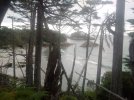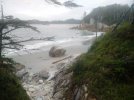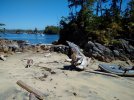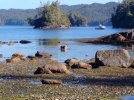Sharphooks
Well-Known Member
After the tide change I found an anchorage that would be a staging point for my spring hole the next morning. It turned out to be one more semi-sleepless night of rocking and rolling in the swells and spinning on the anchor as the NW blow blew itself out. There was a full moon that night, offering its blinding white light so I could clearly see the whirling horizon as the boat spun on its anchor, leaving me urpy with vertigo.
I wish I could say I was exaggerating these descriptions of my nightly anchorages but unfortunately, these descriptions might even be a bit understated. I typically anchor in very tight quarters where a 5/1 scope would be out of the question. I normally use a 3/1 scope which compels a mariner to put a huge amount of trust in his anchor, chain, and the shackle holding them together. All is well in protected anchorages when using an abbreviated scope like that but in an exposed anchorage, it can get dicey.
One night I anchored in a small cove just past Idol Point in Seaforth Channel. I’d gotten away with this anchorage in year’s past, though with smaller boats, and used a 2/1 scope to keep the boat on a tight leash and off the rock ledges that jut out into
the cove on low tides. This year, with a bigger boat, I used a 3/1 scope, but that left my stern hanging out in Seaforth channel. It was dark and I was too exhausted to go find another anchorage, having just run in from Milbanke in a pounding rain and building wind. I’d take a chance and see what happened.
That night another storm. Then some time during the wee hours, a large ship went down Seaforth Channel, producing a huge wake. The wake lifted my boat well over a meter. The dog yelped and landed on my chest.
The next morning with 5 foot breakers in Seaforth and a nasty wind, I found that when the ship passed by with its wake the night before (right in the peak of a 15 foot tide) the swell had been just enough to lift my anchor out of the sand where I’d dropped it and redeposit it hard and fast to the rocks. I was hung up in a rockpile and this was absolutely the worst time to hang an anchor in the rocks.
I used my experience as a steelhead fishermen to get it free. When your lead gets hung up while bottom bouncing in a river, you need to wade upsteam to find the correct angle to free the lead, the goal being to find the same angle that deposited it there in the first place. The only way I could get this angle with my boat was backing the stern into those 5 foot breakers with slack rode line, then get the rode back in the gypsy. That move did the trick--- the anchor popped free but wow, the heart was pounding and the palms were sweating because I knew I’d just dodged another big dripping bullet. I got the hell out of there and went back to Shearwater.
The last day of the trip I was fishing a few spots south of Caution in Queen Charlotte Strait. There was another boomer high tide and enough wind to produce some big seas. In one of those spots, you need to be tight up against some big rocks. Using a 9.9 kicker motor, I always have my finger poised on the start button of my main engine. With the clapotis effect that can sometimes suck your boat into the rocks, you have to be on high alert and be able to bring in horsepower reinforcements in a hurry
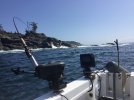 So I hook a spring. It goes under the boat and I’m only a few meters away from the rocks in roiling big water. I go WOT on the kicker to get away from the rocks. A few more runs from the spring and the hooks pull. I’m philosophical about fishing...some times you’re hot....sometimes you’re not...but losing that fish was my signal loud and clear to pull the plug on the trip. Flirting with rocks in big water with big wind was wearing on me and I pulled in my gear and fired up the two mains.
So I hook a spring. It goes under the boat and I’m only a few meters away from the rocks in roiling big water. I go WOT on the kicker to get away from the rocks. A few more runs from the spring and the hooks pull. I’m philosophical about fishing...some times you’re hot....sometimes you’re not...but losing that fish was my signal loud and clear to pull the plug on the trip. Flirting with rocks in big water with big wind was wearing on me and I pulled in my gear and fired up the two mains.
I later discovered that the gas tank I used to run the kicker was completely empty...bone dry....when the hooks pulled on that spring and I’d fired up the main outboards to beat a retreat from the rocks, I was running on gas fumes remaining in the carburetor and what was left in the hose. If I had hung on to that spring, I would have found out the hard way that the tank was empty. The unanswered question remained: would I have been able to fire up the mains quick enough to stay off the rocks?
Like I said when I started this post: this trip was a bit of a crusade and once you know it’s a crusade, you have to know when to call it off.
Alot of effort, maybe a bit more adventure then I bargained for, but I hadn’t sunk the boat and I’d brought the dog back home safe and sound
and she got lots of exercise.
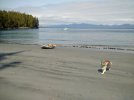
But I was done.
I wish I could say I was exaggerating these descriptions of my nightly anchorages but unfortunately, these descriptions might even be a bit understated. I typically anchor in very tight quarters where a 5/1 scope would be out of the question. I normally use a 3/1 scope which compels a mariner to put a huge amount of trust in his anchor, chain, and the shackle holding them together. All is well in protected anchorages when using an abbreviated scope like that but in an exposed anchorage, it can get dicey.
One night I anchored in a small cove just past Idol Point in Seaforth Channel. I’d gotten away with this anchorage in year’s past, though with smaller boats, and used a 2/1 scope to keep the boat on a tight leash and off the rock ledges that jut out into
the cove on low tides. This year, with a bigger boat, I used a 3/1 scope, but that left my stern hanging out in Seaforth channel. It was dark and I was too exhausted to go find another anchorage, having just run in from Milbanke in a pounding rain and building wind. I’d take a chance and see what happened.
That night another storm. Then some time during the wee hours, a large ship went down Seaforth Channel, producing a huge wake. The wake lifted my boat well over a meter. The dog yelped and landed on my chest.
The next morning with 5 foot breakers in Seaforth and a nasty wind, I found that when the ship passed by with its wake the night before (right in the peak of a 15 foot tide) the swell had been just enough to lift my anchor out of the sand where I’d dropped it and redeposit it hard and fast to the rocks. I was hung up in a rockpile and this was absolutely the worst time to hang an anchor in the rocks.
I used my experience as a steelhead fishermen to get it free. When your lead gets hung up while bottom bouncing in a river, you need to wade upsteam to find the correct angle to free the lead, the goal being to find the same angle that deposited it there in the first place. The only way I could get this angle with my boat was backing the stern into those 5 foot breakers with slack rode line, then get the rode back in the gypsy. That move did the trick--- the anchor popped free but wow, the heart was pounding and the palms were sweating because I knew I’d just dodged another big dripping bullet. I got the hell out of there and went back to Shearwater.
The last day of the trip I was fishing a few spots south of Caution in Queen Charlotte Strait. There was another boomer high tide and enough wind to produce some big seas. In one of those spots, you need to be tight up against some big rocks. Using a 9.9 kicker motor, I always have my finger poised on the start button of my main engine. With the clapotis effect that can sometimes suck your boat into the rocks, you have to be on high alert and be able to bring in horsepower reinforcements in a hurry
 So I hook a spring. It goes under the boat and I’m only a few meters away from the rocks in roiling big water. I go WOT on the kicker to get away from the rocks. A few more runs from the spring and the hooks pull. I’m philosophical about fishing...some times you’re hot....sometimes you’re not...but losing that fish was my signal loud and clear to pull the plug on the trip. Flirting with rocks in big water with big wind was wearing on me and I pulled in my gear and fired up the two mains.
So I hook a spring. It goes under the boat and I’m only a few meters away from the rocks in roiling big water. I go WOT on the kicker to get away from the rocks. A few more runs from the spring and the hooks pull. I’m philosophical about fishing...some times you’re hot....sometimes you’re not...but losing that fish was my signal loud and clear to pull the plug on the trip. Flirting with rocks in big water with big wind was wearing on me and I pulled in my gear and fired up the two mains.I later discovered that the gas tank I used to run the kicker was completely empty...bone dry....when the hooks pulled on that spring and I’d fired up the main outboards to beat a retreat from the rocks, I was running on gas fumes remaining in the carburetor and what was left in the hose. If I had hung on to that spring, I would have found out the hard way that the tank was empty. The unanswered question remained: would I have been able to fire up the mains quick enough to stay off the rocks?
Like I said when I started this post: this trip was a bit of a crusade and once you know it’s a crusade, you have to know when to call it off.
Alot of effort, maybe a bit more adventure then I bargained for, but I hadn’t sunk the boat and I’d brought the dog back home safe and sound
and she got lots of exercise.

But I was done.
Last edited:


